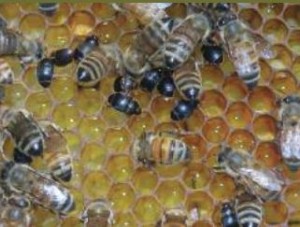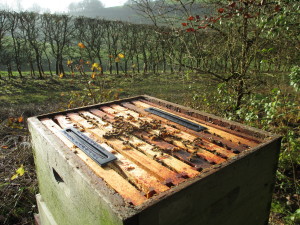Blog – bees, beekeeping & other sticky subjects
Preparing healthy bees for world’s biggest managed pollination
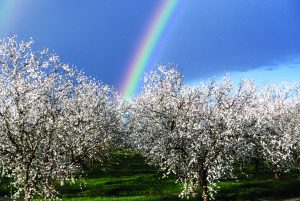 The world’s largest managed pollination event is beginning. Demand for bees to pollinate California’s almond orchards is high and shows no signs of lessening. The area of almond orchards is growing but the availability of bees is declining because of bee disease.
The world’s largest managed pollination event is beginning. Demand for bees to pollinate California’s almond orchards is high and shows no signs of lessening. The area of almond orchards is growing but the availability of bees is declining because of bee disease.
Almonds are big business and the statistics are impressive. California produces about 80% of the world’s commercial almond crop. The 2018 harvest was forecast to be 2.3 billion pounds (more than 1 billion kgs) in weight and it grows year on year. Pollination costs are $400 per acre ($162 per hectare), although the beekeeper is likely to receive up to $200 per colony.
Bees are trucked in from many states to start their annual pollination tour of the country and the economic incentive to have bees ready for this early spring pollination is very high.
A curious way of overwintering bees is developing in California taking ideas from Idaho where bees have been stored over winter in cool, but not freezing, potato sheds.
Idaho produces lots of potatoes and much was stored in large excavated caverns below ground until sold. Since the Idaho winter temperatures can plummet to 20 F, anywhere a constant temperature in the low 40s F can be maintained is valuable. In the winter beekeepers stored their colonies in unused below ground space. Today, huge insulated storage buildings above ground that are temperature- and humidity- controlled have been built
At temperatures in the low 40s F, bees will not attempt to fly, therefore conserve energy and food stores, are less stressed and will have a better chance of emerging healthy and ready for spring pollination
In Bakersfield, California, near the almond orchards, they are learning from Idaho with new-style potato-shed overwintering, but beekeepers there are trying to cope with quite a different climate. Central Valley winter temperatures can fluctuate considerably (but mostly above freezing), so potato-shed style overwintering can lessen unproductive activity in winter warmth and help prepare the bees for the almond orchard pollination in February. There can be as many as 40,000 colonies stored in a temperature-controlled shed. Rental is about $20 per colony.
One bee farmer is renting out 15,000 colonies this year. It’s big business and healthy bees are key.
SHB – Why do bees lock ‘em up?
Some of the reactions of honey bee workers to the small hive beetle (SHB – Aethina tumida) are very curious. SHB is a serious pest of honey bees and, where the beetle is present, Apis mellifera beekeepers are having to learn how to help their bees cope with it.
Native to sub-Saharan Africa, SHB was first seen in North America in 1996, Australia in 2002, and in Europe – southern Italy – in 2015. Once established in an area, SHB has proved impossible to eradicate.
SHB invades colonies creating a disgusting mess of fermented honey, eggs and larvae. They roam the hive and the females will lay their eggs in cracks and crevices.
Jerry Hayes, of Vita Bee Health North America, has dealt with many SHB pest alerts and says the beetles are expert at selecting weak hives. “They seem to detect honey bee stress pheromones from miles away. They are a secondary predator taking advantage of honey bee colonies that have declining populations and are losing the ability to police themselves. Why are the colonies the weakening? It’s usually down poor varroa management. And the beetles keep attacking the weakest colonies”
Beekeepers can place a Beetle Blaster trap between frames in a brood box to act as a sentinel or as longer-term protection.
In sub-Saharan Africa, the African bee, Apis scutellata, will often simply abscond and start a new nest elsewhere leaving behind the horrible mess created by the pest. The western honey bee, Apis mellifera, is less likely to abscond.
If the bees don’t abscond, what then? Some curious habits have been observed. Workers have been seen feeding SHB – perhaps fooled by some pheromone emitted by SHB.
A more effective honey bee response has been to chase the beetles around the nest to herd them into corners where the beetles are then imprisoned behind a wall of propolis. But here is the very curious part: the bees don’t just leave them there to die; they often make small windows in the propolis jail walls through which they feed the beetles! The beetles cannot escape but they are fed. SHB seem to be able to trick some workers (but not all) into feeding them. No-one quite understands why.
Meantime, stingless bees (Trigona carbonaria) are more ruthless in their treatment of SHB. They coat invading beetles with a lethal mix of resin wax and mud. No further treatment is required!
See also: Robin Moritz and Robin Crewe, The Dark Side of the Hive, OUP, 2018.
Unexpected threat left by Hurricane Michael
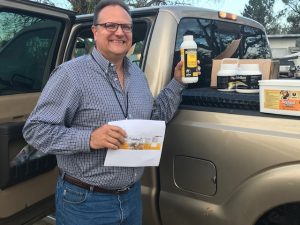
Jerry Hayes of Vita Bee Health has stepped up to help beekeepers in the Florida Panhandle following the third most intense Atlantic hurricane ever. In October, an estimated 3000 honey bee colonies suffered the brunt of Hurricane Michael when it made landfall in the Florida Panhandle and blew its way north through the Carolinas. The main damage took a surprising form.
Although one commercial beekeeper reported losing 200 colonies mainly because the roofs came off in the hurricane leaving the colonies exposed to robbing, the danger for most beekeepers’ colonies was to be in the weeks following the hurricane.
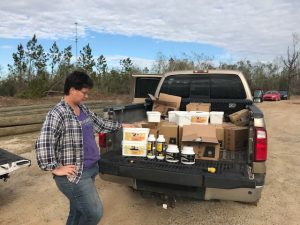
Tony Hogg, president of the Florida Beekeepers Association, explained that physical damage was not the main problem. Many hives survived, but the damage to pollen and nectar sources was huge.
Assessing the situation and knowing the area well from his time as Florida’s chief apiary inspector, Jerry Hayes, Vita’s vice president in North America, said, “I quickly realised that the most effective way of helping beekeepers and bees to recover from the damage – and the potential colony losses to come – was to provide a range of feed products. Local forage had been decimated and will take months to recover. Meanwhile the bees will be without food – not just nectar, but even more importantly pollen to help the colonies build up and recover. By the beginning of December, I had arranged the distribution of sufficient VitaFeed Power, Vita BeeFood and VitaFeed Nutri to feed 1000 colonies.”
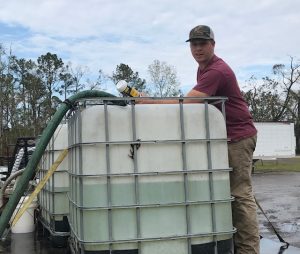 Grateful for the contribution, Tony Hogg told Jerry Hayes, “I would like to thank you and Vita Bee Health for your contribution to the recovery effort. It has been a challenge for all to make it come together but a worthwhile challenge. The contributions have made an impact as folks are getting bees back into shape.”
Grateful for the contribution, Tony Hogg told Jerry Hayes, “I would like to thank you and Vita Bee Health for your contribution to the recovery effort. It has been a challenge for all to make it come together but a worthwhile challenge. The contributions have made an impact as folks are getting bees back into shape.”
The life of a USA apiary inspector
Jerry Hayes talks to Ohio’s state apiary inspector
 Barb Bloetscher is the state entomologist and apiary inspector for Ohio, USA. Jerry Hayes, who once held a similar post in Florida and who is now Vita’s North American VP, talks to Barb and finds out that the Ohio forage is currently insufficient for the resident bee population and what her team is doing to tackle that and other challenges faced by Ohio’s beekeepers.
Barb Bloetscher is the state entomologist and apiary inspector for Ohio, USA. Jerry Hayes, who once held a similar post in Florida and who is now Vita’s North American VP, talks to Barb and finds out that the Ohio forage is currently insufficient for the resident bee population and what her team is doing to tackle that and other challenges faced by Ohio’s beekeepers.
Hello Barb, what is your job and how has your career journey taken you from university to now?
As the state entomologist and state apiarist for the Ohio Department of Agriculture (ODA), I oversee the Apiary Program and identify insects and other arthropods submitted by ODA nursery inspectors and other clients.
More specifically for the Apiary Program, Ohio has 88 counties, most of which appoint and pay a county apiary inspector to inspect the apiaries in that county for pests and diseases. I train the inspectors and check the progress of their inspections as well as help solve problems that arise.
I also spend a great deal of time answering questions from the public, media and municipalities regarding honey bees and beekeeping. My 35 years of keeping bees helps me understand the challenging aspects of maintaining honey bee colonies.
Before my current job, I was the diagnostician for the Diagnostic Clinic at The Ohio State University Department of Entomology. That involved identifying insects and damage caused by insects plus performing extension work in Entomology. I was also the agronomic diagnostician for the Clinic totaling 23 years at OSU. Prior to these positions, I worked at a retail nursery and pest control company, all of which gave me experience working with insects and different kinds of clientele. I have wanted to be an entomologist since third grade, so I chose jobs that would provide the most knowledge and experience.
Why are you leading efforts in honey bees now?
Ohio has a strong history in beekeeping and agriculture. I am helping to ensure a healthy beekeeping industry, which benefits all of agriculture.
Why Ohio and the Ohio Department of Agriculture (ODA)?
Ohio is rich in history and diverse in geography, ecosystems and agriculture. The four corners of Ohio are as uniquely different as are the types of crops and animals raised. Beekeeping varies too, as some areas have acres of hills and pasture while other areas are farmed with row crops with commercial apiaries and hobby beekeepers within five miles of each other. Each beekeeper and apiary has its own challenges which makes my job intriguing and requiring more answers.
Can you briefly describe the ODA apiary and beekeeping inspection system?
Yes, here are some basis statistics:
6500 beekeepers
65% are hobbyists, 25% sideliners, and 10% commercial.
Experience varies from new beekeepers to those with 50+ years of beekeeping.
Lack of knowledge and experience is the biggest challenge.
The lack of knowledge and experience is understandable: a colony of bees is a microcosm of 30,000-50,000 half-sisters and half-brothers, all with different genetic makeup and habits. Each colony is genetically different with varying needs and weaknesses. It is therefore very difficult to learn how to keep a colony of honey bees alive, especially if the person does not have a strong background in biology.
We work with local bee clubs and give presentations to help educate beekeepers on new issues affecting the industry, as well as providing annual training for county bee inspectors.
How can you improve beekeeper management success for hobby, sideline and commercial beekeepers in Ohio and further in the USA as a whole?
What a loaded question! To improve the beekeeping industry in Ohio as well as the USA and elsewhere, we need to improve three components:
Increase the educational resources available to beekeepers.
Increase and improve habitat for bees and other pollinators.
Produce stronger, more mite- and disease-resistant honey bee genetics.
Beekeepers look in many directions for information – that includes the internet, other beekeepers, magazines and books — some of which have outdated, misleading or even wrong advice. Novice beekeepers don’t know where to turn and often don’t know which advice to follow. Good information is available online but can be hard to find.
We need to develop a highly visible network of resource websites that are easy to find and provide the information and research updates to help beekeepers find the best information. The online factsheet site, eXtension, is helpful but not sufficient for all the beekeepers’ needs, while the Honey Bee Health Coalition website has not yet garnered enough attention.
USDA (United States Department of Agriculture) has estimated that each colony of honey bees requires 2-5 acres of forage with sufficient quantities of nutrient rich nectar and pollen available for the entire season. Ohio has 43,000 colonies yet lacks the necessary 215,000 acres of “bee food”. We need to set more land aside for wildflowers and reduce the acres of non-flowering land.
Ohio doesn’t have enough colonies for all the pollination needs in Ohio, so colonies and packages are brought from other states. Packages of starter colonies are also purchased to replace lost colonies. Many times, these colonies don’t have the ability to withstand Ohio conditions, or were raised under duress and have poor genetics. Varroa mites continue to be the primary pest of honey bees which weaken the bees and predispose them to virus and disease.
Can you summarise where you have been and how you want to move forward?
Ohio has been working on programs to enhance the three components needed to improve honey bee health and beekeeper success. Along with presenting information to state and local beekeeping clubs, we have partnered with STEM (science technology engineering mathematics) and other educational groups to inform students, the public and beekeepers on best management practices for beekeeping.
We have worked with allied associations and state agencies to raise understanding of pollinator needs and helped with relations between growers and beekeepers. By participating in the USDA APHIS Honey Bee Health Survey for seven years, we have worked with beekeepers all over the state and collected data on honey bee health which can be compared to national results.
Through the Propolis Project, ODA has helped to establish and study colonies at Wright Patterson Airforce Base which has 40,000 acres of clover, woods and wildflowers. These colonies consist of feral and Purdue “ankle-biter” stock that have kept mite levels down and flourished.
Our program’s main goals are to improve the beekeeping industry in Ohio and promote local beekeepers. Through partnerships and projects, we will continue to attain our goals while maintaining compliance with Ohio apiary laws and rules.
Installing ApiShield is so easy
Sebastian an Paulo demonstrate how easy it is to install Apishield as an Asian hornet sentinel and as a long-term trap for pests attacking the colony in late summer onwards.

